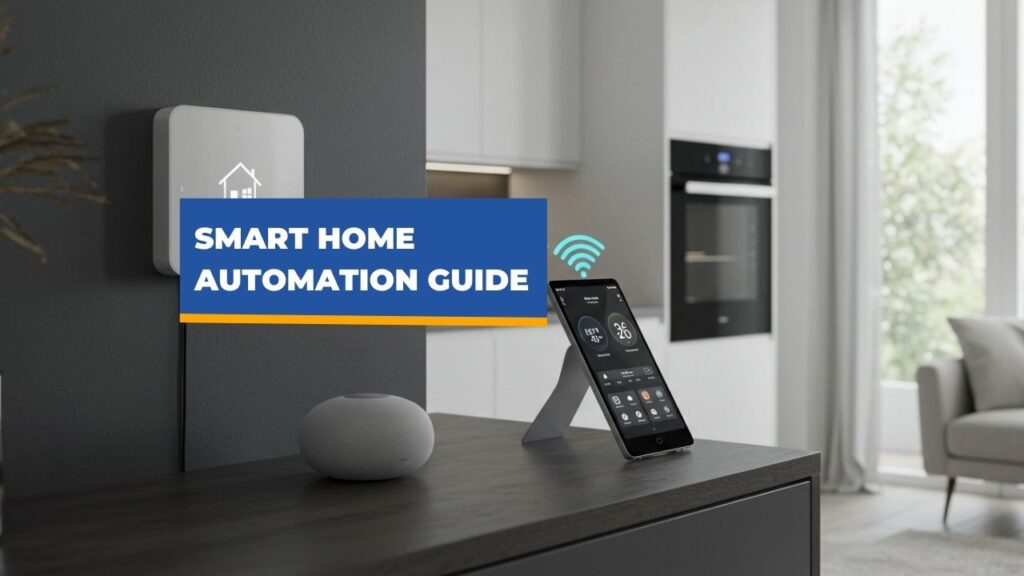Disclosure Information
Disclosure: This article contains affiliate links. If you make a purchase through one of these links, our team may earn a commission at no extra cost to you. Learn more. Thanks for your support!
Transforming your living space into a smart home has never been more accessible. The global smart home market is experiencing explosive growth, with projections reaching $622.59 billion by 2026 (source: Fortune Business Insights). This comprehensive guide will walk you through creating your intelligent living space from the ground up.
Understanding Smart Home Basics
A smart home ecosystem consists of connected devices that automate tasks, enhance security, improve energy efficiency, and simplify daily life. The foundation of any smart home is interconnectivity, with devices communicating with each other and with you, creating a seamless experience that responds to your needs and preferences.
Smart homes offer compelling benefits beyond convenience:
- Smart thermostats can reduce heating and cooling costs by up to 23% (source: Nest Labs)
- Connected security systems decrease break-in risk by 60% (source)
- Smart home features can increase property values by 5% on average (source)
Planning Your Smart Home: First Steps
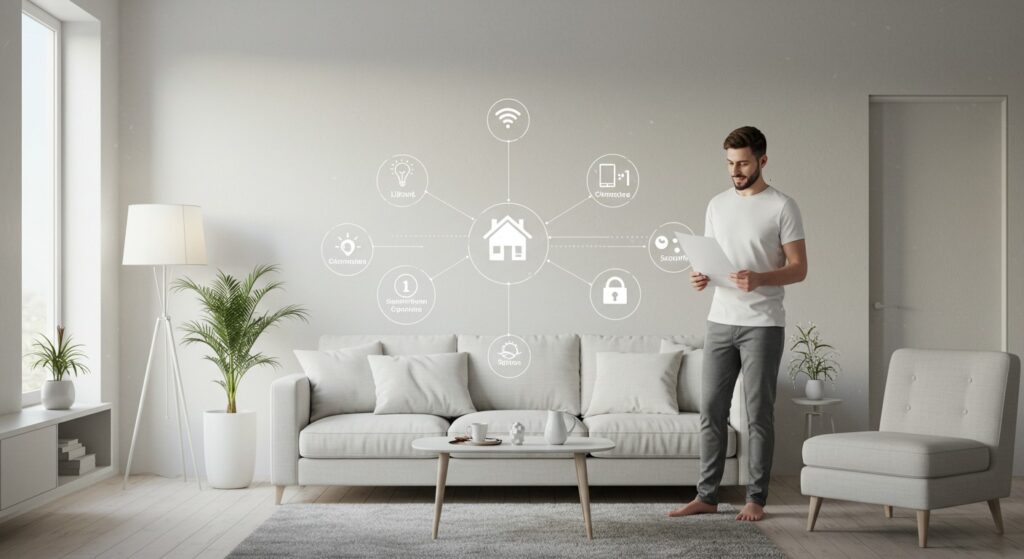
Assess Your Needs and Goals
Begin by identifying what you want to achieve with your smart home. Are you focused on security, energy savings, entertainment, or convenience? Your priorities will guide your investment decisions. Consider your lifestyle patterns, including travel frequency, work schedule, and whether you have pets or children.
Evaluate Your Current Infrastructure
Before purchasing devices, assess your home’s infrastructure:
- A reliable, high-speed internet connection is essential (recommended speeds of at least 25 Mbps)
- Identify Wi-Fi dead zones; larger homes may require mesh network systems
- Consider your home’s construction; older homes with thick walls may require signal boosters
- Note locations of available power outlets, particularly in areas where you plan to cluster smart technology
Setting a Budget
Smart home technology spans from budget-friendly to premium options. Determine your overall budget, then allocate funds based on priority areas.
| Budget Level | Investment Range | Scope |
| Starter | $200-$500 | Basic hub + 2-3 devices |
| Mid-range | $500-$2,000 | Comprehensive system |
| Premium | $2,000+ | Whole-home automation |
“Goal-Setting Worksheet” – Ask Yourself:
What problems do you want to solve with a smart home?
- ☐ Security? (e.g., Home security, remote monitoring, peace of mind)
- ☐ Energy Savings? (e.g., Lower energy bills, efficient heating/cooling, smart lighting)
- ☐ Convenience & Automation? (e.g., Simplified routines, hands-free control, automated tasks)
- ☐ Entertainment? (e.g., Multi-room audio, smart TV integration, immersive lighting)
- ☐ Accessibility? (e.g., Voice control for easier device operation for those with mobility challenges)
- ☐ Other? (Specify: __________)
Which areas of your home do you want to automate or make “smart”?
- ☐ Lighting
- ☐ Security System (Door/Window Sensors, Cameras)
- ☐ Thermostat & Climate Control
- ☐ Entertainment (TV, Audio)
- ☐ Kitchen Appliances
- ☐ Garden/Outdoor
- ☐ Whole Home
What’s your budget range for starting your ecosystem?
- ☐ Entry-Level (Under $300)
- ☐ Mid-Range ($300 – $700)
- ☐ Premium ($700+)
What’s your tech comfort level?
- ☐ Beginner (Just starting with smart tech)
- ☐ Intermediate (Comfortable with basic tech, willing to learn)
- ☐ Tech-Savvy (Enjoy tinkering and advanced customization)
Choosing Your Smart Home Hub
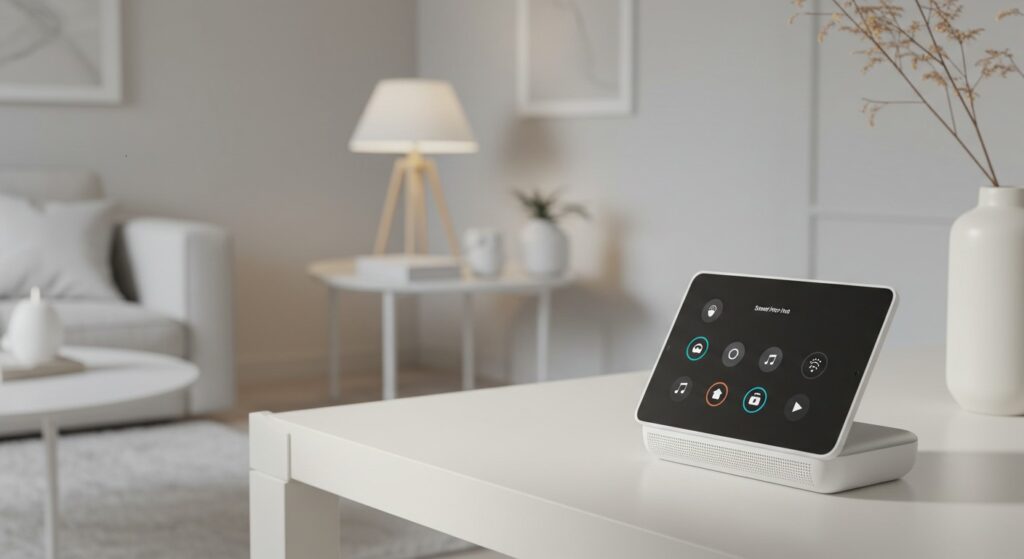
The hub serves as the command center for your smart home, enabling different devices to work together. This critical decision affects compatibility with future purchases.
Voice Assistant Hubs
These slim, consumer-friendly devices combine voice control with smart home management capabilities.
Pros:
- Simple setup with minimal technical knowledge required
- Natural voice interaction for intuitive control
- Continuous improvement through regular software updates
- Often more affordable than dedicated hubs
Cons:
- Some privacy concerns regarding always-listening microphones
- Occasional command misinterpretation or connectivity issues
- May have more limited device compatibility than dedicated hubs
- Potential ecosystem lock-in to specific manufacturers
Best for: General users seeking an intuitive, voice-first smart home experience.
Amazon Echo (Alexa) — Best Overall Voice Assistant Hub
Amazon’s Echo devices provide the most extensive third-party device support with straightforward setup and operation.
| Feature | Details | Rating |
| Compatibility | Works with 100,000+ smart devices | 9/10 |
| Voice Recognition | Excellent, even in noisy environments | 8/10 |
| Hub Capabilities | Includes Zigbee in some models | 8/10 |
| Privacy Features | Physical mute button, voice recording deletion | 7/10 |
| Price Range | $25-$250 depending on model | 9/10 |
Google Nest (Google Assistant) — Best for Natural Conversation
Google’s assistant provides the most natural language processing with seamless integration into Google’s ecosystem.
| Feature | Details | Rating |
| Compatibility | Works with 50,000+ smart devices | 8/10 |
| Voice Recognition | Superior natural language understanding | 9/10 |
| Hub Capabilities | Limited built-in protocols | 7/10 |
| Privacy Features | Physical mute switch, activity controls | 7/10 |
| Price Range | $50-$230 depending on model | 8/10 |
Apple HomePod (Siri) — Best for Privacy
Apple’s approach prioritizes privacy with excellent sound quality and seamless Apple ecosystem integration.
| Feature | Details | Rating |
| Compatibility | Works with HomeKit-certified devices only | 6/10 |
| Voice Recognition | Good, but less flexible than competitors | 7/10 |
| Hub Capabilities | Full HomeKit hub functionality | 8/10 |
| Privacy Features | Industry-leading privacy protection | 10/10 |
| Price Range | $99-$299 depending on model | 6/10 |
Dedicated Smart Home Hubs
These specialized controllers focus exclusively on smart home device management with advanced automation capabilities.
Pros:
- Superior device compatibility across multiple protocols
- More robust automation capabilities
- Often provide local processing (works without internet)
- Greater privacy with less reliance on cloud services
Cons:
- Usually requires more technical knowledge to set up
- Additional cost beyond voice assistants
- Less intuitive user interfaces
- May lack voice control without additional devices
Best for: Tech-savvy users seeking maximum flexibility and advanced automation capabilities.
Samsung SmartThings — Best Overall Dedicated Hub
SmartThings offers exceptional device compatibility with straightforward automation creation.
| Feature | Details | Rating |
| Compatibility | Works with Z-Wave, Zigbee, Wi-Fi, and more | 9/10 |
| Automation Capabilities | Powerful rules engine with logical operators | 9/10 |
| Local Processing | Limited local control | 6/10 |
| User Interface | Clean, intuitive app design | 8/10 |
| Price | $70-$300 depending on package | 8/10 |
Hubitat Elevation — Best for Local Control
Hubitat processes automations locally, providing enhanced privacy and reliability during internet outages.
| Feature | Details | Rating |
| Compatibility | Excellent Z-Wave and Zigbee support | 8/10 |
| Automation Capabilities | Advanced rule creation and scripting | 9/10 |
| Local Processing | Full local processing with no cloud requirement | 10/10 |
| User Interface | Somewhat technical, steeper learning curve | 6/10 |
| Price | $130-$200 | 7/10 |
Essential Smart Home Categories
1. Smart Lighting
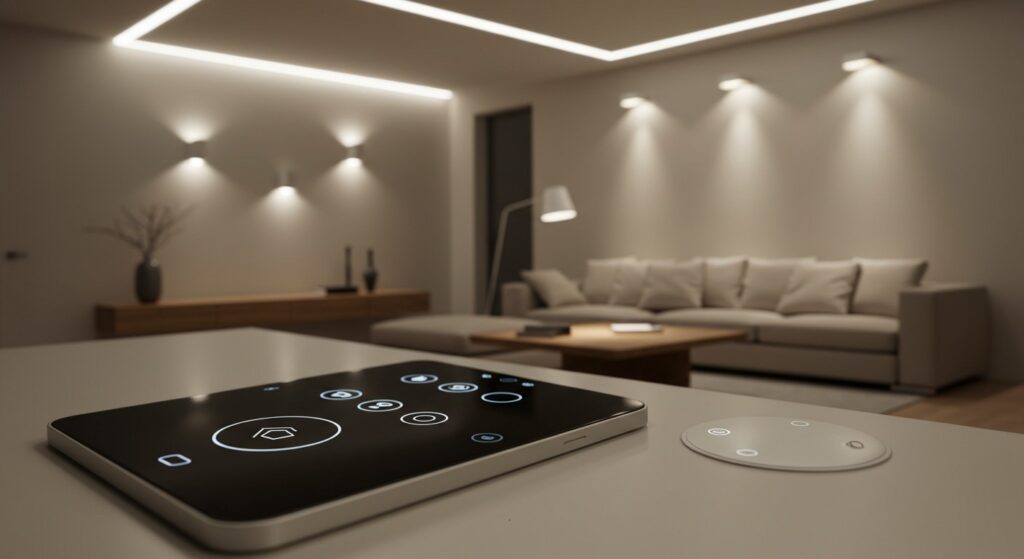
These connected light bulbs, switches, and plugs offer convenience, energy savings, and ambiance customization.
Pros:
- Significant convenience through automation and remote control
- Energy savings through occupancy detection and scheduling
- Enhanced home security with away-from-home control
- Customizable ambiance for different activities and moods
Cons:
- Higher initial cost compared to traditional lighting
- May require hub devices for full functionality
- Potential compatibility issues between brands
- Occasional connectivity problems
Best for: Everyone – lighting is the ideal entry point for smart home adoption.
Types of Smart Lighting
Smart Bulbs
These direct replacements for traditional light bulbs connect to your network for remote control.
Pros:
- Easiest installation with no electrical work required
- Often include color-changing capabilities
- Can be moved between fixtures as needed
- Perfect for renters and non-permanent installations
Cons:
- More expensive than traditional bulbs
- Requires network reconnection if power is cut
- Not ideal for fixtures with multiple bulbs (cost)
- Wall switches must remain on to function
Best for: Renters, those uncomfortable with electrical work, and color-changing applications.
Philips Hue — Best Overall Smart Bulb System
The market leader with the most extensive ecosystem of lighting products and accessories.
| Feature | Details | Rating |
| Reliability | Exceptional connection stability | 9/10 |
| Brightness | Up to 1100 lumens depending on model | 8/10 |
| Color Quality | Excellent color reproduction | 9/10 |
| Ecosystem | Extensive options including outdoor | 10/10 |
| Price | $25-$50 per bulb (plus bridge) | 7/10 |
LIFX — Best Hub-Free Color Bulbs
Direct Wi-Fi connection eliminates the need for a hub while providing vibrant colors.
| Feature | Details | Rating |
| Reliability | Good but occasional Wi-Fi issues | 7/10 |
| Brightness | Industry-leading 1100+ lumens | 10/10 |
| Color Quality | Vibrant with excellent saturation | 9/10 |
| Ecosystem | Growing but limited compared to Hue | 7/10 |
| Price | $35-$60 per bulb (no hub required) | 7/10 |
Wyze Bulb — Best Budget Option
Remarkable value with reliable performance and basic smart features.
| Feature | Details | Rating |
| Reliability | Surprisingly stable connections | 8/10 |
| Brightness | Good at 800-1100 lumens | 8/10 |
| Color Quality | Basic but functional | 7/10 |
| Ecosystem | Limited but expanding | 6/10 |
| Price | $8-$15 per bulb (no hub required) | 10/10 |
Smart Switches
These wall-mounted replacements for traditional light switches add connectivity while working with existing bulbs.
Pros:
- Control multiple lights with one device
- More cost-effective for fixtures with multiple bulbs
- Familiar wall control remains functional
- Works with any bulb type, including non-smart bulbs
Cons:
- Installation requires electrical knowledge
- Most require neutral wires (often absent in older homes)
- Limited color control capabilities
- Permanent installation not ideal for renters
Best for: Homeowners looking for whole-room control and the most cost-effective solution for multiple fixtures.
Lutron Caseta — Best Overall Smart Switch System
Renowned for reliability and compatibility with older homes without neutral wires.
| Feature | Details | Rating |
| Reliability | Industry-leading stability | 10/10 |
| Installation | Works without neutral wire | 9/10 |
| Compatibility | Works with most voice assistants | 8/10 |
| Design | Attractive with tactile buttons | 8/10 |
| Price | $60-$80 per switch (plus bridge) | 7/10 |
TP-Link Kasa — Best Value Smart Switch
Affordable switches with excellent performance and no required hub.
| Feature | Details | Rating |
| Reliability | Very good connection stability | 8/10 |
| Installation | Requires neutral wire | 7/10 |
| Compatibility | Works with most voice assistants | 8/10 |
| Design | Clean, traditional appearance | 7/10 |
| Price | $15-$25 per switch (no hub required) | 9/10 |
Leviton Decora Smart — Best Premium Smart Switch
High-quality construction with advanced features for discerning homeowners.
| Feature | Details | Rating |
| Reliability | Excellent connection stability | 9/10 |
| Installation | Requires neutral wire | 7/10 |
| Compatibility | Works with most ecosystems | 9/10 |
| Design | Professional appearance | 9/10 |
| Price | $40-$60 per switch | 7/10 |
Smart Plugs
These adaptable devices convert regular outlets into smart-controlled sockets for lamps and appliances.
Pros:
- Simplest installation with zero technical knowledge required
- Highly portable and can be moved as needed
- Works with any plug-in device, not just lighting
- Perfect for controlling holiday decorations and fans
Cons:
- Bulky design may block adjacent outlets
- Limited to controlling on/off (rarely dimming)
- Visible hardware may be aesthetically displeasing
- Not suitable for hardwired lighting fixtures
Best for: Non-technical users, controlling non-lighting devices, and temporary smart control needs.
TP-Link Kasa Mini — Best Overall Smart Plug
Compact design with reliable performance and no required hub.
| Feature | Details | Rating |
| Reliability | Excellent connection stability | 9/10 |
| Size | Compact design doesn’t block outlets | 9/10 |
| Features | Energy monitoring, away mode | 8/10 |
| App Quality | Intuitive and responsive | 8/10 |
| Price | $15-$20 per plug | 9/10 |
Wyze Plug — Best Budget Smart Plug
Exceptional value with surprising reliability and basic features.
| Feature | Details | Rating |
| Reliability | Very good for the price | 8/10 |
| Size | Reasonably compact | 7/10 |
| Features | Basic scheduling and grouping | 7/10 |
| App Quality | Simple and functional | 7/10 |
| Price | $8-$15 per plug | 10/10 |
Eve Energy — Best for Apple HomeKit
Superior HomeKit integration with Thread protocol support for enhanced reliability.
| Feature | Details | Rating |
| Reliability | Excellent with Thread support | 9/10 |
| Size | Somewhat bulky | 6/10 |
| Features | Detailed energy monitoring, trends | 9/10 |
| App Quality | Excellent data presentation | 9/10 |
| Price | $35-$45 per plug | 6/10 |
2. Smart Security

Connected security devices provide peace of mind through monitoring, alerts, and integration with other smart systems.
Pros:
- Remote monitoring provides peace of mind anywhere
- Real-time alerts for unusual activity
- Integration with other smart devices enhances security
- Often more affordable than traditional security systems
Cons:
- Many features require subscription plans
- Potential privacy concerns with cloud storage
- May require professional installation for some components
- Dependent on reliable internet connection
Best for: All homeowners and even renters seeking enhanced security with flexible installation options.
Types of Smart Security Devices
Video Doorbells
These front door sentinels combine doorbell functionality with video surveillance for package and visitor monitoring.
Pros:
- See and speak with visitors without opening the door
- Record package deliveries and deter porch pirates
- Motion detection alerts for activity near your door
- Many models work with existing doorbell wiring
Cons:
- Best features often require subscription plans
- Wi-Fi signal challenges in some door locations
- Privacy concerns for neighbors and passersby
- Installation challenges in some housing situations
Best for: Anyone concerned about front door security, package deliveries, or visitor screening.
Ring Video Doorbell — Best Overall Video Doorbell
Pioneer in the category with reliable performance and comprehensive neighborhood features.
| Feature | Details | Rating |
| Video Quality | 1080p HD with HDR | 8/10 |
| Installation | Wired or battery options | 9/10 |
| Smart Features | Good motion detection, zones | 8/10 |
| Subscription Value | $3-$10/month with good features | 7/10 |
| Price | $100-$250 depending on model | 8/10 |
Nest Doorbell — Best Smart Detection
Superior AI capabilities distinguish between people, packages, animals, and vehicles.
| Feature | Details | Rating |
| Video Quality | 1080p HD with HDR | 8/10 |
| Installation | Wired or battery options | 8/10 |
| Smart Features | Industry-leading AI detection | 10/10 |
| Subscription Value | More free features than competitors | 8/10 |
| Price | $180-$280 depending on model | 7/10 |
Eufy Video Doorbell — Best Subscription-Free Option
Local storage eliminates monthly fees while maintaining excellent performance.
| Feature | Details | Rating |
| Video Quality | 2K resolution with HDR | 9/10 |
| Installation | Wired or battery options | 8/10 |
| Smart Features | Good detection with local processing | 8/10 |
| Subscription Value | No subscription required | 10/10 |
| Price | $150-$200 depending on model | 8/10 |
Security Cameras
These vigilant observers monitor indoor and outdoor spaces with remote viewing and recording capabilities.
Pros:
- View live feed from anywhere with internet access
- Record evidence of suspicious activity
- Receive alerts when motion is detected
- Some models feature two-way communication
Cons:
- Privacy considerations for household members
- Battery-powered models require regular charging
- Most advanced features require subscriptions
- Wired models may require professional installation
Best for: Both homeowners and renters seeking flexible monitoring solutions for property protection.
Arlo Pro 4 — Best Overall Wireless Camera
Exceptional quality and flexibility with wire-free installation and excellent features.
| Feature | Details | Rating |
| Video Quality | 2K HDR with color night vision | 9/10 |
| Battery Life | 3-6 months between charges | 8/10 |
| Smart Features | Advanced detection, activity zones | 9/10 |
| Weatherproofing | Excellent outdoor durability | 9/10 |
| Price | $180-$250 per camera | 7/10 |
Ring Stick Up Cam — Best Ecosystem Integration
Seamless integration with Ring doorbells and alarm systems for unified security.
| Feature | Details | Rating |
| Video Quality | 1080p HD | 7/10 |
| Battery Life | 3-6 months between charges | 8/10 |
| Smart Features | Good motion detection, zones | 7/10 |
| Weatherproofing | Good outdoor durability | 8/10 |
| Price | $100-$180 per camera | 8/10 |
Wyze Cam v3 — Best Budget Camera
Remarkable value with features competing with cameras costing three times as much.
| Feature | Details | Rating |
| Video Quality | 1080p with color night vision | 8/10 |
| Battery Life | Wired only (power required) | 6/10 |
| Smart Features | Person detection included free | 7/10 |
| Weatherproofing | Good outdoor durability | 8/10 |
| Price | $30-$50 per camera | 10/10 |
Smart Locks
These door guardians replace or enhance traditional locks with keyless entry and remote access control.
Pros:
- Eliminate the need for physical keys
- Grant temporary access to guests or service providers
- Lock/unlock remotely when away from home
- Track who enters and exits with detailed logs
Cons:
- Potential battery failure concerns
- More complex installation than other smart devices
- Usually more expensive than traditional locks
- May require bridge devices for remote access
Best for: Homeowners seeking convenience, enhanced access control, and elimination of key management.
August Smart Lock Pro — Best Retrofit Option
Works with your existing deadbolt, maintaining exterior appearance while adding smart features.
| Feature | Details | Rating |
| Installation | Works with existing deadbolt | 9/10 |
| Remote Access | Requires bridge device | 7/10 |
| Auto-Lock Features | Geofencing, time-based locking | 9/10 |
| Guest Access | Excellent temporary access options | 9/10 |
| Price | $150-$230 (plus bridge) | 7/10 |
Schlage Encode — Best All-in-One Smart Lock
Built-in Wi-Fi eliminates the need for a separate bridge with excellent reliability.
| Feature | Details | Rating |
| Installation | Replaces entire deadbolt | 7/10 |
| Remote Access | Built-in Wi-Fi, no bridge needed | 9/10 |
| Auto-Lock Features | Timer-based auto-locking | 8/10 |
| Guest Access | Up to 100 access codes | 8/10 |
| Price | $250-$300 | 7/10 |
Yale Assure Lock — Best Modular Smart Lock
Flexible connectivity options allow upgrading as technology evolves.
| Feature | Details | Rating |
| Installation | Replaces entire deadbolt | 7/10 |
| Remote Access | Depends on module (Z-Wave, Wi-Fi) | 8/10 |
| Auto-Lock Features | Timer-based auto-locking | 8/10 |
| Guest Access | Up to 250 access codes | 9/10 |
| Price | $180-$270 (plus module) | 7/10 |
Alarm Systems
These comprehensive protection platforms integrate various sensors and monitoring options.
Pros:
- Whole-home protection with multiple sensor types
- Professional monitoring options without long contracts
- Integration with other smart devices for enhanced security
- Usually include cellular backup for power/internet outages
Cons:
- Higher overall cost than individual security devices
- May require subscription for full functionality
- More complex setup than standalone devices
- Some components may require professional installation
Best for: Homeowners seeking comprehensive security beyond individual components.
Ring Alarm — Best Value Alarm System
Affordable self-installation with flexible monitoring and excellent smart home integration.
| Feature | Details | Rating |
| Components | Good quality sensors and devices | 8/10 |
| Monitoring Cost | $10/month optional professional | 9/10 |
| Installation | Simple DIY with no tools needed | 9/10 |
| Smart Integration | Excellent with Ring, Alexa | 8/10 |
| Price | $200-$500 for starter kits | 9/10 |
SimpliSafe — Best Overall Alarm System
Exceptional reliability with flexible monitoring and straightforward operation.
| Feature | Details | Rating |
| Components | Excellent quality sensors | 9/10 |
| Monitoring Cost | $15-$25/month optional professional | 8/10 |
| Installation | Easy DIY with no tools needed | 9/10 |
| Smart Integration | Good but somewhat limited | 7/10 |
| Price | $230-$500 for starter kits | 8/10 |
Abode — Best Smart Home Integration
Advanced automation capabilities with excellent third-party device compatibility.
| Feature | Details | Rating |
| Components | Very good quality sensors | 8/10 |
| Monitoring Cost | $6-$20/month with on-demand option | 10/10 |
| Installation | Moderate DIY difficulty | 7/10 |
| Smart Integration | Excellent with many platforms | 9/10 |
| Price | $280-$650 for starter kits | 7/10 |
3. Climate Control
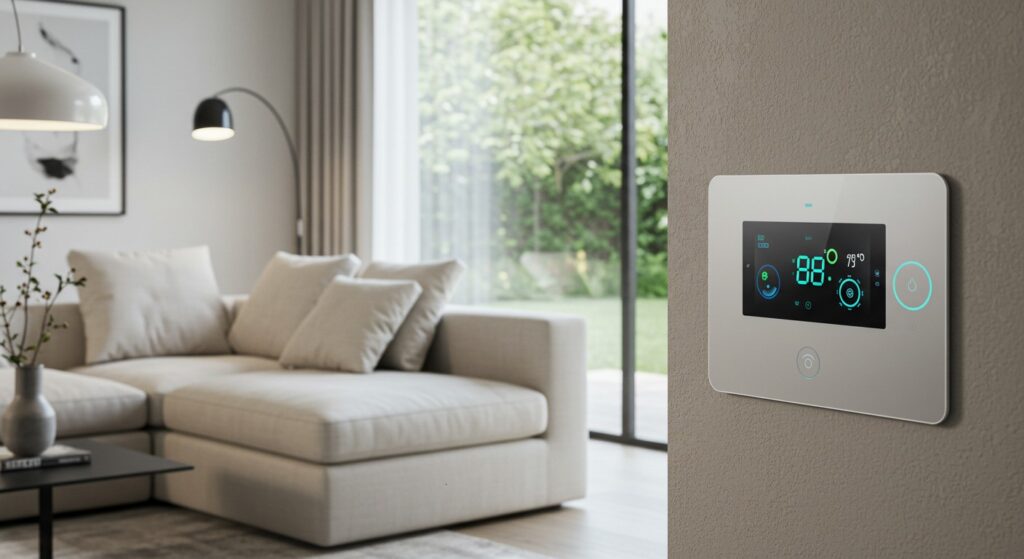
Smart climate devices optimize comfort while reducing energy consumption through intelligent automation.
Pros:
- Significant energy savings potential
- Enhanced comfort through learning and adaptation
- Remote control when away from home
- Integration with other smart home systems
Cons:
- Higher initial cost than traditional alternatives
- Some models require professional installation
- Occasional connectivity issues
- May have compatibility limitations with HVAC systems
Best for: Homeowners looking to enhance comfort while reducing energy bills.
Types of Climate Control Devices
Smart Thermostats
These intelligent temperature controllers learn your preferences and optimize for comfort and efficiency.
Pros:
- Potential energy savings of 10-23% on heating/cooling
- Remote temperature adjustment from anywhere
- Learning capabilities adapt to your schedule
- Detailed energy usage reports
Cons:
- Compatibility issues with some HVAC systems
- Often require C-wire which older homes may lack
- More complex setup than traditional thermostats
- Premium features may require subscription
Best for: Most homeowners with compatible HVAC systems seeking comfort and energy savings.
Ecobee SmartThermostat — Best Overall Smart Thermostat
Room sensors and built-in voice control create a comprehensive climate solution.
| Feature | Details | Rating |
| Temperature Control | Excellent with room sensors | 9/10 |
| Energy Reports | Comprehensive with suggestions | 9/10 |
| Installation | Includes power adapter for no C-wire | 8/10 |
| Smart Features | Built-in Alexa, detailed scheduling | 9/10 |
| Price | $170-$250 | 7/10 |
Nest Learning Thermostat — Best Self-Programming Thermostat
Elegant design with excellent learning algorithm that adapts to your habits.
| Feature | Details | Rating |
| Temperature Control | Very good, optional sensors | 8/10 |
| Energy Reports | Good with “Leaf” efficiency indicator | 8/10 |
| Installation | Can work without C-wire in some setups | 7/10 |
| Smart Features | Excellent learning capabilities | 9/10 |
| Price | $200-$250 | 7/10 |
Honeywell Home T9 — Best Multi-Room Thermostat
Excellent sensor implementation for homes with significant temperature variations.
| Feature | Details | Rating |
| Temperature Control | Excellent with smart room sensors | 9/10 |
| Energy Reports | Basic but functional | 7/10 |
| Installation | Requires C-wire | 6/10 |
| Smart Features | Room prioritization, geofencing | 8/10 |
| Price | $150-$200 | 8/10 |
Smart Ceiling Fans
These connected overhead fans improve air circulation while coordinating with your HVAC system.
Pros:
- Enhance heating/cooling efficiency
- Remote control of speed and direction
- Scheduling and automation capabilities
- Integration with smart thermostats
Cons:
- Higher cost than traditional ceiling fans
- Installation more complex than other smart devices
- Limited selection compared to traditional fans
- May require bridge devices for some features
Best for: Homeowners looking to supplement HVAC systems with efficient air circulation.
Big Ass Fans Haiku — Best Premium Smart Fan
Exceptional quality with built-in sensors and automation capabilities.
| Feature | Details | Rating |
| Air Movement | Industry-leading efficiency | 10/10 |
| Noise Level | Virtually silent operation | 10/10 |
| Smart Features | Built-in sensors, learning capabilities | 9/10 |
| Design | Stunning modern aesthetics | 9/10 |
| Price | $900-$1,500 | 5/10 |
Hunter SimpleConnect — Best Mid-Range Smart Fan
Reliable performance with good connectivity at a reasonable price.
| Feature | Details | Rating |
| Air Movement | Very good efficiency | 8/10 |
| Noise Level | Quiet but not silent | 7/10 |
| Smart Features | Basic scheduling and voice control | 7/10 |
| Design | Traditional with modern touches | 7/10 |
| Price | $250-$400 | 8/10 |
Modern Forms — Best Design-Focused Smart Fan
Architecturally distinctive designs with reliable smart capabilities.
| Feature | Details | Rating |
| Air Movement | Good efficiency | 8/10 |
| Noise Level | Very quiet operation | 8/10 |
| Smart Features | Good app control and integration | 8/10 |
| Design | Contemporary, distinctive aesthetics | 9/10 |
| Price | $400-$700 | 7/10 |
Smart Vents
These adjustable air vents provide room-specific temperature control for enhanced comfort.
Pros:
- Room-by-room temperature control
- Potential energy savings by not heating/cooling unused spaces
- Scheduling capabilities for different rooms
- Can address hot/cold spots in homes
Cons:
- May affect HVAC system pressure if too many vents closed
- More expensive than traditional vents
- Battery replacement maintenance required
- Limited compatibility with some HVAC systems
Best for: Homeowners with significant temperature variations between rooms.
Flair Smart Vent — Best Overall Smart Vent
Excellent compatibility with leading thermostats and pressure sensing for safety.
| Feature | Details | Rating |
| Airflow Control | Motorized with pressure monitoring | 9/10 |
| Battery Life | 2-3 years with standard batteries | 8/10 |
| Smart Features | Works with major thermostats | 9/10 |
| Installation | Simple replacement of existing vents | 8/10 |
| Price | $80-$90 per vent | 7/10 |
Keen Home Smart Vent — Best for Smaller Systems
Good balance of performance and value with reliable mesh network.
| Feature | Details | Rating |
| Airflow Control | Good motorized control | 8/10 |
| Battery Life | 1-2 years with standard batteries | 7/10 |
| Smart Features | Temperature sensors, scheduling | 8/10 |
| Installation | Straightforward DIY installation | 8/10 |
| Price | $70-$85 per vent | 7/10 |
EcoNet Smart Vent — Best Energy Efficiency
Energy-efficient design with excellent battery life and reliable performance.
| Feature | Details | Rating |
| Airflow Control | Efficient motorized control | 8/10 |
| Battery Life | Industry-leading 4+ years | 10/10 |
| Smart Features | Basic but functional | 7/10 |
| Installation | Simple magnetic installation | 9/10 |
| Price | $65-$80 per vent | 8/10 |
4. Smart Entertainment Systems
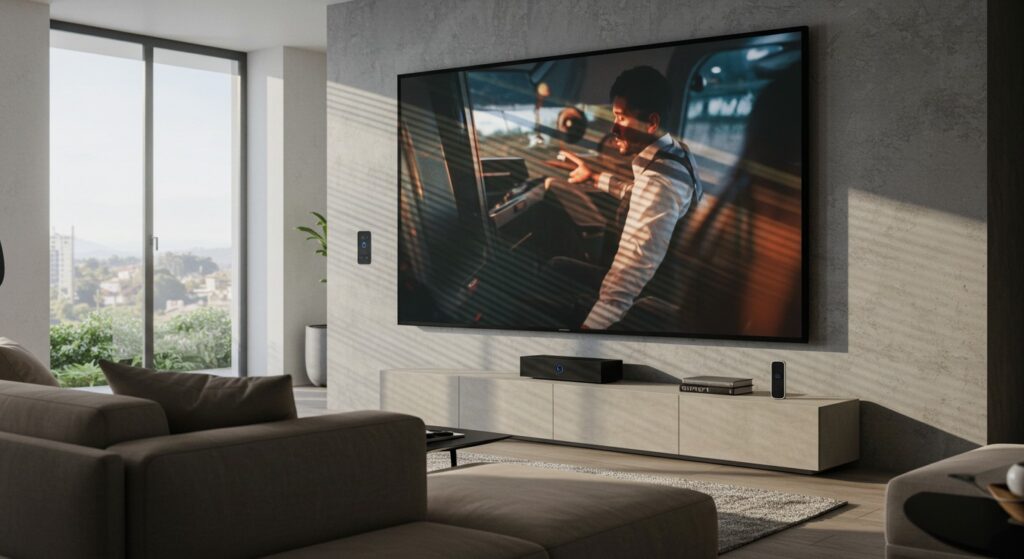
Connected entertainment devices centralize control and integrate with other smart home components.
Pros:
- Consolidated control of multiple entertainment sources
- Voice control eliminates remote control hunting
- Integration with lighting and other smart devices
- Regular updates add features and improve performance
Cons:
- Higher cost than traditional entertainment components
- Potential obsolescence as standards evolve
- Occasional software glitches or update issues
- Privacy concerns with always-listening devices
Best for: Media enthusiasts seeking simplified control and integration with smart home features.
Types of Entertainment Devices
Smart TVs
These connected televisions provide streaming capabilities and smart home dashboard functions.
Pros:
- Built-in streaming eliminates separate devices
- Regular software updates add features
- Voice control capabilities
- Smart home dashboard functionality
Cons:
- Operating systems may become outdated
- Privacy concerns with viewing habits tracking
- Smart features often slower than dedicated devices
- Varying app support between platforms
Best for: Anyone seeking simplified entertainment setup with integrated streaming capabilities.
LG OLED (WebOS) — Best Picture Quality
Exceptional display technology with intuitive smart platform and good home integration.
| Feature | Details | Rating |
| Picture Quality | Perfect blacks, excellent colors | 10/10 |
| Smart Platform | Fast, intuitive WebOS interface | 9/10 |
| Voice Control | Good with built-in options | 8/10 |
| Smart Home Integration | Works with major platforms | 8/10 |
| Price | $1,300-$3,000+ depending on size | 6/10 |
Samsung QLED (Tizen) — Best Bright Room Performance
Extremely bright displays with excellent smart home integration through SmartThings.
| Feature | Details | Rating |
| Picture Quality | Excellent brightness, good colors | 9/10 |
| Smart Platform | Clean, responsive Tizen interface | 8/10 |
| Voice Control | Good with multiple assistant options | 8/10 |
| Smart Home Integration | Excellent with SmartThings | 9/10 |
| Price | $900-$2,500+ depending on size | 7/10 |
TCL Roku TV — Best Value Smart TV
Exceptional value with intuitive interface and excellent content discovery.
| Feature | Details | Rating |
| Picture Quality | Very good for the price | 8/10 |
| Smart Platform | Excellent, intuitive Roku interface | 9/10 |
| Voice Control | Basic but functional | 7/10 |
| Smart Home Integration | Limited but improving | 6/10 |
| Price | $300-$1,000+ depending on size | 10/10 |
Streaming Devices
Streaming devices are compact, dedicated gadgets that connect to your TV to provide access to streaming services like Netflix, Hulu, and YouTube. They’re ideal for upgrading non-smart TVs or enhancing smart TVs with faster performance and broader app support.
Pros:
- Affordable way to add streaming to any TV
- Often faster and more responsive than smart TV interfaces
- Wide app compatibility
- Portable and easy to set up
Cons:
- Requires an additional device and remote
- Dependent on TV quality for picture and sound
- Some models lack advanced features like voice control
- May need occasional updates or replacement as tech evolves
Best for:
Tech enthusiasts who want the latest features, users with older TVs, or those dissatisfied with their smart TV’s performance.
Top Recommendations for Streaming Devices:
A. Roku Ultra — Best Overall Streaming Experience
Fast performance, 4K HDR support, and an intuitive interface with broad app availability.
| Feature | Details | Rating |
| Performance | Quick, reliable streaming | 9/10 |
| Picture Quality | 4K HDR, Dolby Vision | 9/10 |
| Interface | Simple, customizable Roku OS | 9/10 |
| Voice Control | Voice remote included | 8/10 |
| Price | $100 | 8/10 |
B. Amazon Fire TV Stick 4K Max — Best for Alexa Users
Powerful streaming with seamless integration into Amazon’s ecosystem.
| Feature | Details | Rating |
| Performance | Fast with Wi-Fi 6 support | 9/10 |
| Picture Quality | 4K HDR, Dolby Vision/Atmos | 9/10 |
| Interface | Alexa-focused, slightly cluttered | 8/10 |
| Voice Control | Excellent with Alexa | 9/10 |
| Price | $60 | 9/10 |
C. Apple TV 4K — Best for Apple Ecosystem
Premium build, smooth integration with Apple devices, and top-tier performance.
| Feature | Details | Rating |
| Performance | Lightning-fast A15 Bionic chip | 10/10 |
| Picture Quality | 4K HDR, Dolby Vision/Atmos | 10/10 |
| Interface | Sleek tvOS, app-focused | 9/10 |
| Voice Control | Siri works well | 9/10 |
| Price | $129-$149 | 7/10 |
Smart Speakers
Smart speakers combine high-quality audio with voice assistants, doubling as entertainment hubs and smart home controllers. They’re perfect for music, podcasts, and hands-free control of other devices.
Pros:
- Excellent sound quality for music and media
- Voice assistant integration (Alexa, Google Assistant, Siri)
- Can control smart home devices
- Compact and versatile placement
Cons:
- Limited as standalone entertainment without pairing to other devices
- Privacy concerns with always-listening microphones
- Sound quality varies widely by price
- Requires stable internet for full functionality
Best for:
Music lovers, smart home enthusiasts, and anyone who enjoys voice-controlled convenience.
Top Recommendations for Smart Speakers:
A. Amazon Echo (4th Gen) — Best All-Around Smart Speaker
Great sound, affordable price, and deep Alexa integration.
| Feature | Details | Rating |
| Sound Quality | Rich, balanced with good bass | 8/10 |
| Voice Assistant | Alexa, highly responsive | 9/10 |
| Smart Home Control | Excellent hub with Zigbee | 9/10 |
| Design | Sleek, spherical | 8/10 |
| Price | $100 | 9/10 |
B. Google Nest Audio — Best for Google Users
Crisp audio and seamless integration with Google Assistant.
| Feature | Details | Rating |
| Sound Quality | Clear, loud, good for music | 9/10 |
| Voice Assistant | Google Assistant, very smart | 9/10 |
| Smart Home Control | Works with Google ecosystem | 8/10 |
| Design | Minimalist, fabric finish | 8/10 |
| Price | $100 | 9/10 |
C. Apple HomePod (2nd Gen) — Best for Apple Fans
Premium sound and tight integration with Apple’s ecosystem.
| Feature | Details | Rating |
| Sound Quality | Exceptional, room-filling audio | 10/10 |
| Voice Assistant | Siri, improving but limited | 7/10 |
| Smart Home Control | HomeKit support, reliable | 8/10 |
| Design | Elegant, compact | 9/10 |
| Price | $299 | 6/10 |
5. Smart Appliances
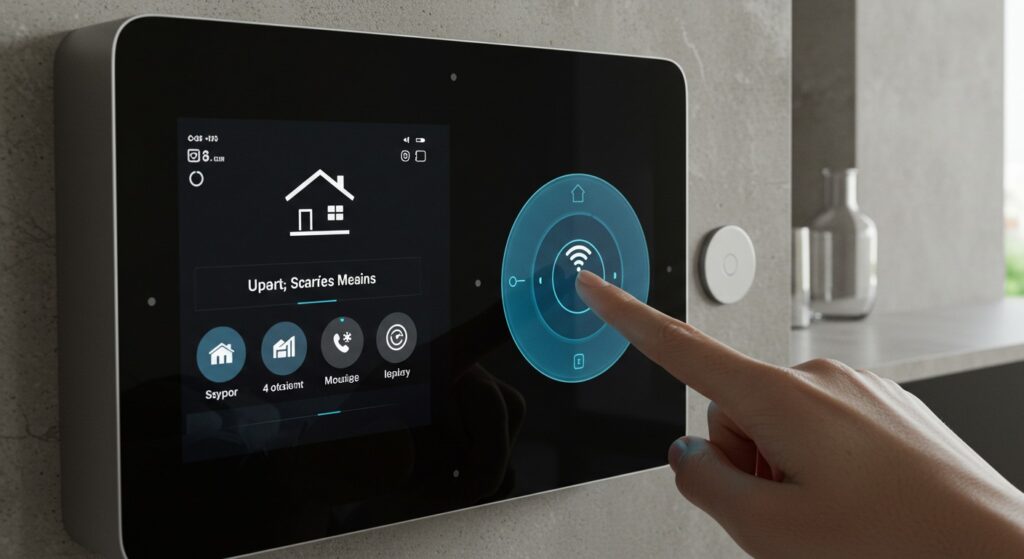
Smart appliances are home devices enhanced with connectivity features, such as Wi-Fi or Bluetooth, allowing them to be controlled remotely via apps or voice assistants like Alexa, Google Assistant, or Siri. These appliances often incorporate AI to automate tasks, improve efficiency, and integrate with smart home ecosystems. They range from kitchen gadgets to laundry machines and beyond, offering convenience, energy savings, and sometimes even entertainment options.
Pros:
- Remote Control: Adjust settings or monitor progress from anywhere using a smartphone or voice commands.
- Automation: AI features can optimize performance, like adjusting cooking times or laundry cycles based on load.
- Energy Efficiency: Many smart appliances track usage and suggest ways to reduce power or water consumption.
- Integration: Seamlessly connect with other smart home devices for a cohesive experience.
Cons:
- Cost: Higher upfront price compared to traditional appliances.
- Complexity: Setup and troubleshooting can be trickier, especially with connectivity issues.
- Privacy Risks: Internet-connected devices may collect data, raising concerns about security and tracking.
- Dependence on Tech: Requires a stable internet connection and compatible devices for full functionality.
Best for:
Busy households, tech-savvy users, and those looking to modernize their home with efficient, connected solutions.
Top Recommendations for Smart Appliances:
A. Samsung Bespoke AI Refrigerator — Best Smart Kitchen Appliance
A premium refrigerator with a touchscreen “AI Home” display for managing food, suggesting recipes, and controlling other smart devices.
| Feature | Details | Rating |
| Functionality | AI food tracking, recipe suggestions | 9/10 |
| Display | 9-inch or 32-inch Full HD touchscreen options | 9/10 |
| Smart Integration | SmartThings compatibility | 9/10 |
| Design | Sleek, customizable panels | 8/10 |
| Price | $2,000-$4,000+ depending on model | 6/10 |
B. LG ThinQ Washer/Dryer Combo — Best Smart Laundry Solution
A washer-dryer duo with AI fabric detection and remote operation via the ThinQ app.
| Feature | Details | Rating |
| Functionality | Auto-detects fabric and soil level | 9/10 |
| Efficiency | Water and energy-saving tech | 8/10 |
| Smart Features | App control, voice assistant support | 9/10 |
| Durability | Reliable LG build quality | 8/10 |
| Price | $1,500-$2,500 depending on size | 7/10 |
C. Tovala Smart Oven — Best for Smart Cooking
A countertop oven that bakes, broils, roasts, and steams, with app control and QR-code meal kit integration.
| Feature | Details | Rating |
| Functionality | Multi-mode cooking, AI guidance | 9/10 |
| Ease of Use | App-guided recipes, QR scanning | 9/10 |
| Smart Features | Wi-Fi control, no voice assistant | 8/10 |
| Size | Compact for small kitchens | 8/10 |
| Price | $299 (meal kits extra) | 8/10 |
Maintaining Your Smart Home
A smart home with devices like Smart TVs, streaming gadgets, speakers, and appliances needs regular care for performance, security, and durability. Here’s a streamlined guide to keeping your setup in top shape as of March 01, 2025.
Key Maintenance Tips
- Keep Software Updated: Enable auto-updates on devices like LG OLED TVs or Roku Ultra. Check apps (e.g., SmartThings) for appliance firmware monthly.
- Monitor Network Performance: Use a dual-band router, test speeds with Ookla, and upgrade for devices like Fire TV Stick 4K Max if Wi-Fi lags.
- Secure Your Devices: Set strong passwords, enable 2FA on apps like ThinQ, and disable mics/cameras on Echo or Nest when unused. Review router settings for unauthorized access.
- Clean and Inspect Hardware: Dust Smart TVs and speakers with a microfiber cloth, clear vents on Apple TV 4K, and follow cleaning guides for appliances like LG ThinQ Washer every 3-6 months.
- Manage App Clutter: Uninstall unused apps on TCL Roku TV or Tizen platforms via settings. Reset recipe histories on Tovala Smart Oven if sluggish.
- Test Smart Home Integration: After updates, test voice commands (e.g., Alexa with Echo) or app sync (e.g., Samsung appliances with SmartThings). Re-pair if needed.
Troubleshooting Common Issues
- Device offline? Restart device and router, check Wi-Fi strength.
- Slow performance? Clear cache or reduce network load.
- Voice assistant failing? Re-train (e.g., Siri on HomePod) or unmute mic.
- Appliance errors? Check manuals or apps for codes (e.g., LG ThinQ diagnostics).
Conclusion
Building a smart home ecosystem requires thoughtful planning and strategic implementation. By starting with a solid foundation and expanding methodically, you’ll create a system that enhances your lifestyle while avoiding overwhelming complexity.
Success starts with a clear plan—identify your needs like entertainment, security, or efficiency, and build on fast Wi-Fi with a hub like Amazon Echo or SmartThings. Add compatible devices like Philips Hue lights or Ring doorbells, and maintain everything by updating software, securing your network, and testing integrations.
The ultimate win? A smart home that feels effortless—intuitive controls, tailored comfort, and peace of mind—all woven into your daily life without the chaos of tech overload. Start small, scale smart, and enjoy a space that’s as brilliant as it is livable.
